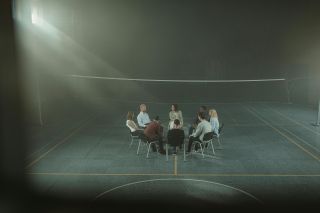Therapy
The Best Way to Lie to Yourself
The importance of balancing positive illusions and reality anchors.
Updated September 18, 2024 Reviewed by Devon Frye
Key points
- We all manage a balance between truth and fiction when appraising our skills and abilities.
- Getting off balance can tip us toward depression or narcissism.
- These positive self-illusions have ripple effects throughout social circles and society.
- Cultural factors can influence how one balances this tradeoff between self-illusion and reality.

This is a companion piece to my previous article, which argued that our identities are based, in part, on lies we tell ourselves.
Even if our self-identities are indeed half-truths, there is still a continuum between fiction and nonfiction and between objective and subjective truth. Thus, finding the right balance between these polar ends is significant to the health and well-being of the person.
The work of Shelley Taylor and Jonathon Brown (1988) went against the then-common idea that accurate perceptions of self and the world are essential for mental health. They argued the opposite—that people must maintain positive illusions about themselves and the world as a pretext for happiness.
Such positive illusions are argued to be evolutionarily advantageous and are crucial to healthy child development. After all, a child who is too accurate in their self-appraisal might throw up their hands and say “What’s the point?”
Balancing Truth and Fiction
As we navigate our day-to-day lives, we must balance a tradeoff between accuracy and happiness. The more accurate we are, the more prone we are to depression, a phenomenon known as “depressive realism.” But the happier we are, the more prone we are to living in a world of self-aggrandizing delusions at significant costs.
Narcissistic personality disorder (NPD) provides an extreme counterpoint to the depressive realism hypothesis. NPD is defined by individuals with a grandiose sense of self-importance and a belief that he or she is unduly special and unique. If positive illusions are necessary for psychological well-being and are indeed evolutionarily advantageous as a result, then NPD could be the end product of those healthy drives pushed into too high of a gear.
The middle point is what psychologists refer to as “healthy narcissism,” a term I was first surprised to hear, believing any dose of narcissism to be bad. But, as I learned, a healthy sense of self-pride is predicated on some degree of illusion. Given the importance of this balance, how do humans learn to stay in an optimal balance between happiness and accuracy?

Throughout human history, we’ve operated within a system of checks and balances that test and calibrate an individual’s sense of self-reality against the objective world—what I refer to as “reality anchors.”
Take, for example, childhood play (though a practice shared by many mammals). Play provides that crucial intersection between what one would like to be and what one is capable of. It is a process of repetitive reality testing as children assess their physical, social, and cognitive abilities in a consequence-free environment—a kind of dress rehearsal for real life.
In our prehistorical past, if a child grew to believe he could single-handedly take down a wooly mammoth (NPD), he’d quickly be trampled. If that same child believed he was incapable of killing even small game (depressive realism), he’d soon starve. Should the child have a finely tuned positive illusion regarding his or her hunting skills, their perceived skills would more likely match the perceived challenge of the task, leading to flow states crucial for learning.
Close-knit social circles provide another source of reality anchors. Conversing with friends, family, and strangers, exposes us to the real world, organically testing our skills, strengths, and perceptions. Without those repeated reality-testing exposures to other humans, individuals can more easily succumb to illusion.
Unfortunately, many Western countries are now in the middle of a loneliness epidemic. A lonelier society is one more prone to runaway illusions. Indeed, a recent study by Bierwiaczonek et al. (2024) suggests loneliness throughout early developmental periods in life may be associated with conspiracist worldviews in midlife.
Equality and Reality Anchors
Some evolutionary psychologists argue that 150 is the maximum number of people a human can effectively maintain stable, meaningful relationships with—what’s known as Dunbar’s number. We were evolutionarily primed to live within small hunter-gatherer groups, this theory goes; go beyond 150 members in a group, and trust quickly frays. Owing to more impersonal relationships, people can begin to cheat and free-ride in the group with fewer consequences.
It's also been argued that religion (and then government, as religiosity declined) formed a kind of cultural evolutionary stopgap to ensure group cohesion beyond the Dunbar number. Because we now live in societies well beyond 150 persons, we are necessarily a cultural species (what’s known as dual-inheritance theory). The tradeoff, however, is that these stories that precipitate trust and social conformity also lead to hierarchy, and a highly unequal society can begin to diminish reality anchors as well.

“Let them eat cake,” Marie Antoinette, the Queen of France, is said to have uttered when she learned the French peasants had no bread. The rich and the famous have long insulated themselves from the realities of the outside world, surrounding themselves with sycophants and yes-men. Today is no exception.
We see this playing out on the supranational stage as well. Some scholars have suggested that Putin’s generals, for example, do not push back on Putin’s demands, leading to a top-down organizational structure that is sclerotic and often misinformed. Contrast this with Ukraine whose forces are compartively democratic and equal and therefore strategically nimble. Soldiers and generals are able to challenge one another without undue consequence, helping them develop a more accurate sense of reality and therefore a better strategic outcome.
Illusion has also recently defined many of our country’s most sensationalized business failures. With Elizabeth Holmes of Theranos, Billy McFarland of the Fyre Festival, and Adam Neuman of WeWork, it’s easy to understand how our present society has lost its reality anchors, giving way to runaway illusions of self-grandeur.
Given the importance of maintaining this balance between accuracy and happiness, between subjective and objective truth, where can we turn to help us restore this crucial balance?
Using Therapy to Test Reality
Talk therapy is one obvious answer. Many psychotherapeutic modalities combine reality testing with re-authoring practices. “What is the percentage likelihood each outcome will happen?” a cognitive behavioral therapist might ask their client, only to then ask that client to develop a more helpful, alternative statement to their concern (re-authoring).
Psychodynamic therapy helps clarify and connect one’s narrative arc to the here-and-now of the therapeutic relationship, testing old relational patterns to then test them against a present reality. Narrative therapy has clients revisit their pasts for overlooked and forgotten facts to then leverage these newfound facts into stories more authentic to the client’s values. Mentalization-based therapy helps clients test their theory of mind toward other persons, using the outcomes to re-author expectations and attitudes in interpersonal conflict. The list goes on.
But individual talk therapy has its limits—and we’ve perhaps overemphasized it in our present society, as therapy-speak increasingly makes its way into our common lexicon. The wisdom here is to get out of your head: help yourself by helping others, or go out and exercise. Or, in the spirit of George Putnam, go join a bowling league.

In commenting on the brilliance of the Balinese culture, the anthropologist Stephen Lansing remarked that they have the ability to “make up an invisible world, watching themselves make it up and still believe in it so strongly that they can enter it.” I’ve long thought of imagination as a prerequisite for mental health.
Take, for example, the placebo effect. Something tangible—a white coat, a sugar pill, even a sham surgery—is the germ that gives way to a theater of care in which the power of imagination can heal.
“All the world’s a stage,” said William Shakespeare. Indeed, in healing ourselves and others, we are all participating in that theater, constantly managing our shared illusions and realities. It’s when we forget that stage that we get ourselves into trouble.
References
Lansing, S. (n.d.) Reflexivity in Balinese Aesthetics. MS. Author’s files.
Taylor, S. E. & Brown, J. D. (1988). Illusion and well-being: A social psychological perspective on mental health. Psychological Bulletin. Vol 103(2), Mar 1988, 193-210.




